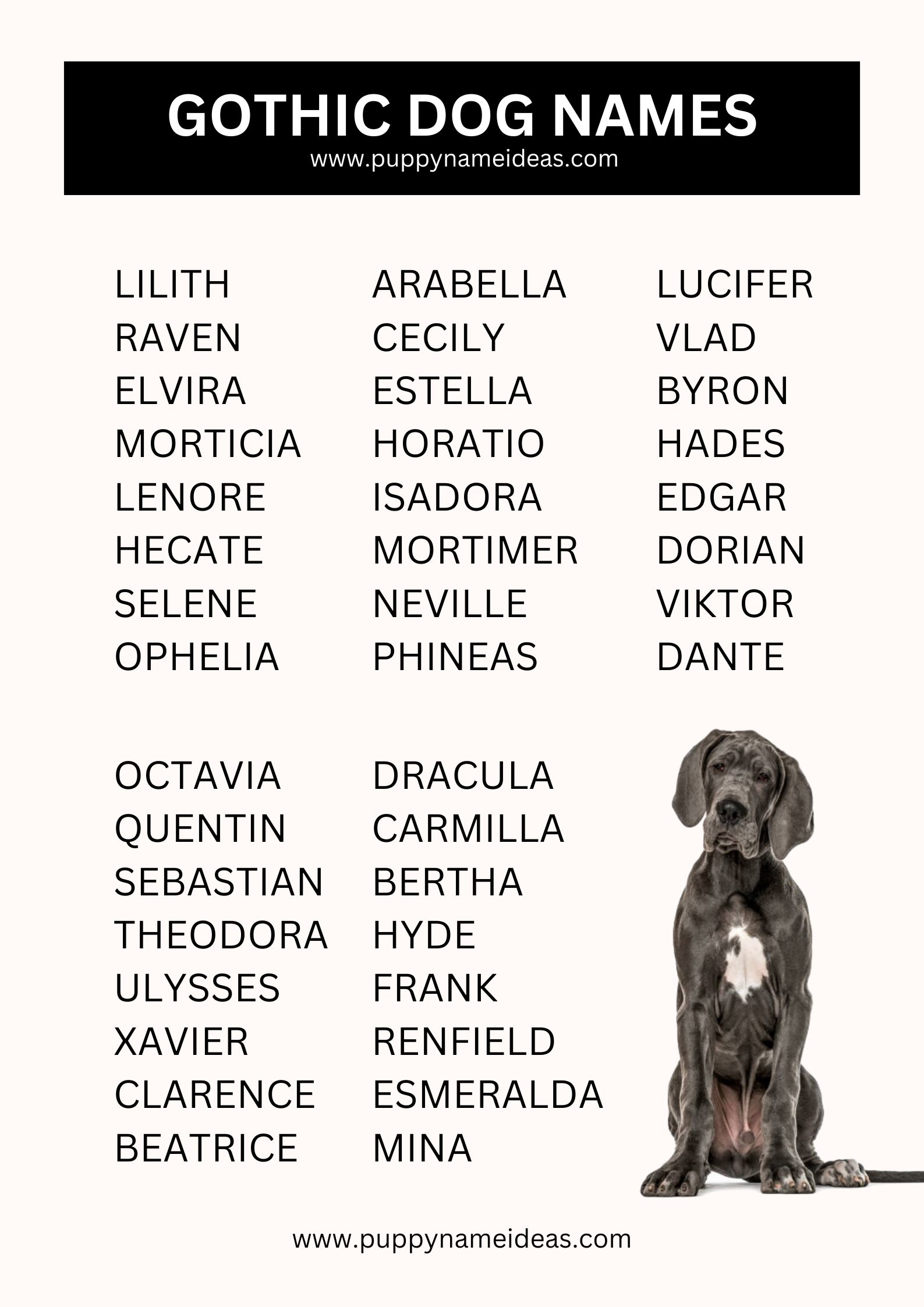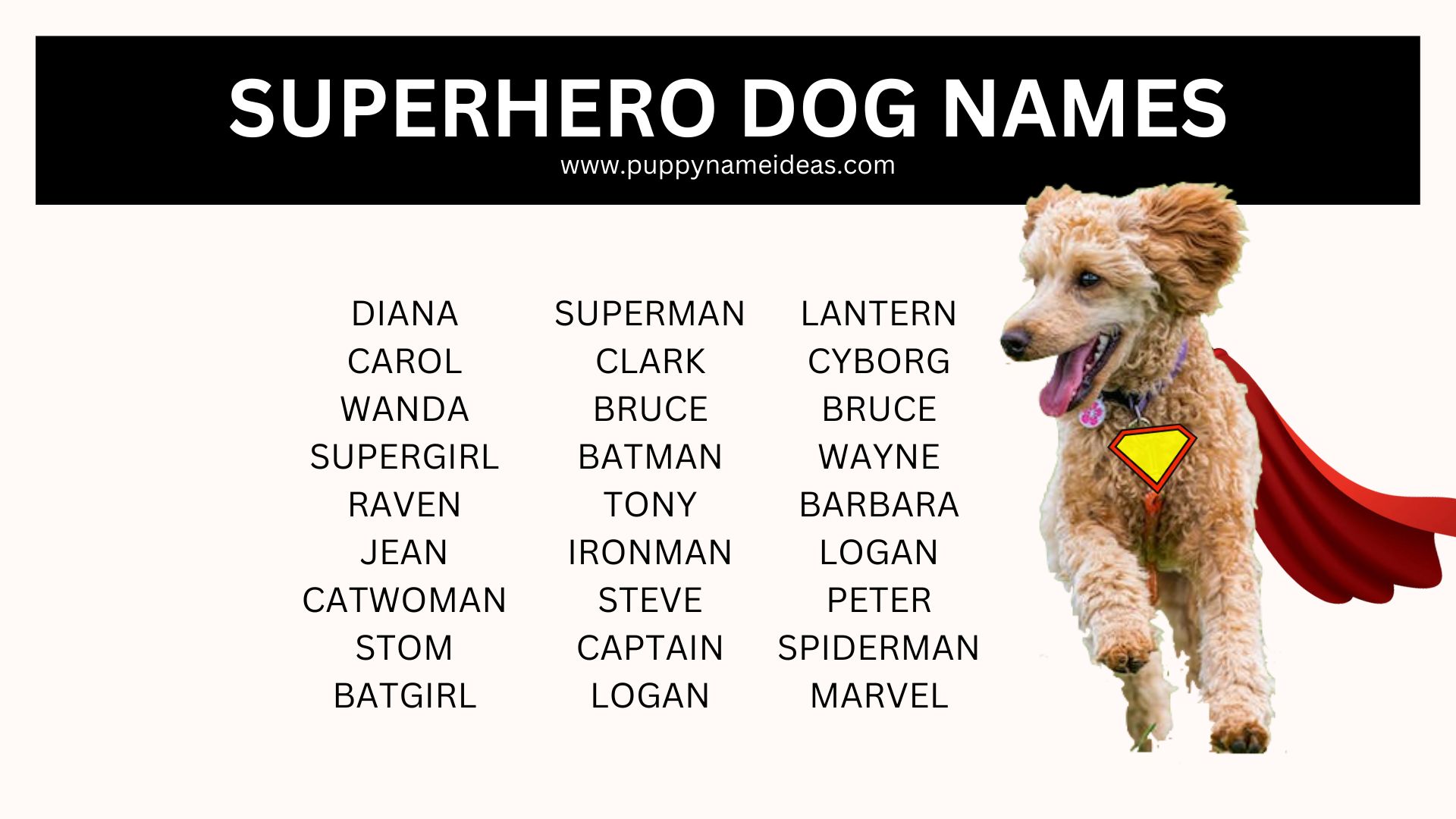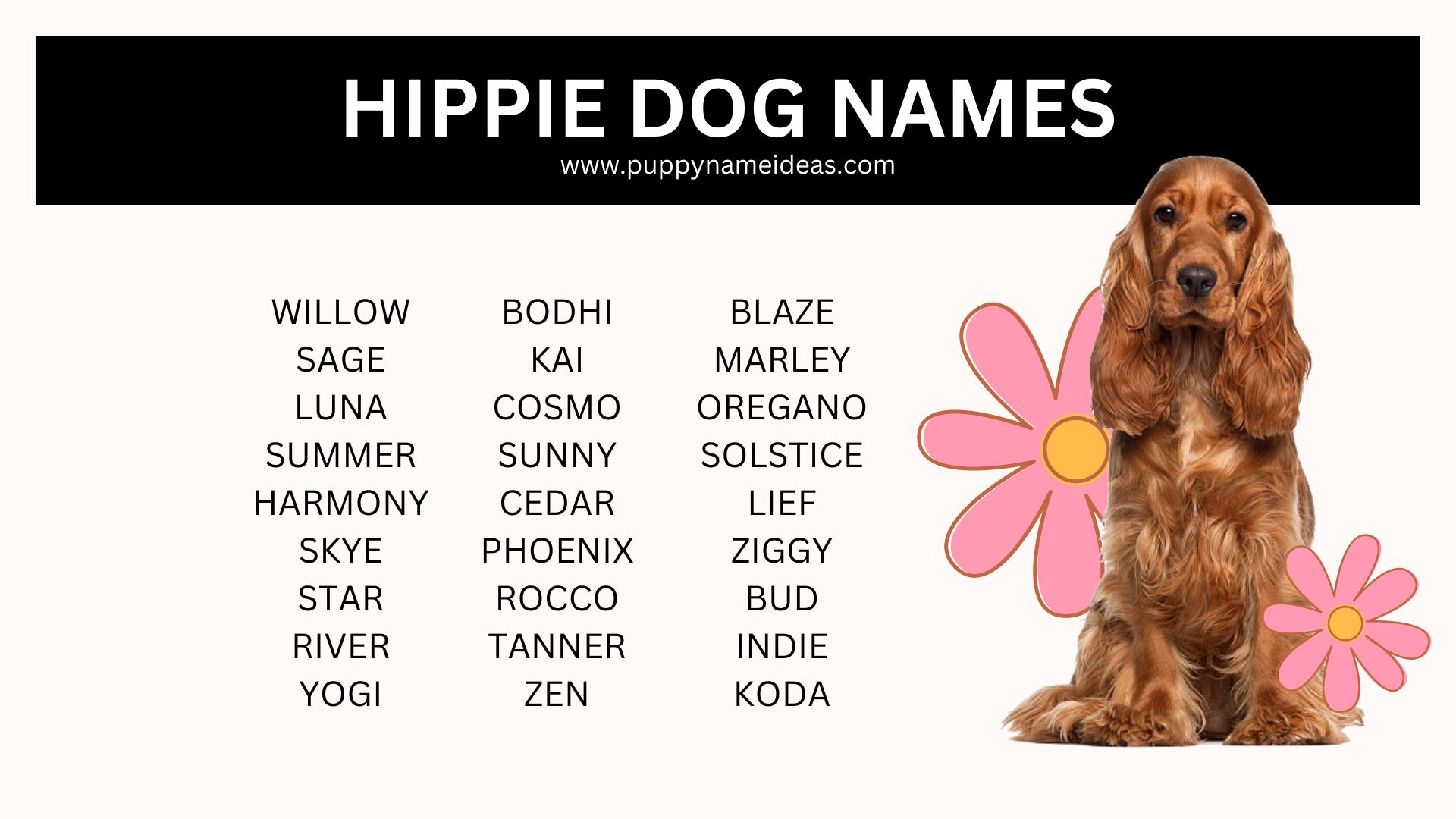210+ Gothic Dog Names

Gothic culture, with its rich history and aesthetic, offers a deep well of inspiration for naming our darkly inclined canine companions. Whether you’re drawn to the romanticism of the Victorian era, the brooding characters of gothic literature, the unique styles of gothic artists, the majestic forms of gothic architecture, or the resonant depths of gothic music, there’s a name out there to suit every shade of the gothic spectrum. This article delves into various categories to help you find the perfect gothic name for your dog.
Female Gothic Dog Names
- Lilith – Named after the figure from Jewish mythology, often associated with the night.
- Raven – Inspired by the bird that symbolizes mystery and the macabre.
- Elvira – After the Mistress of the Dark, a gothic icon.
- Morticia – From the matriarch of the Addams Family, embodying elegance and darkness.
- Lenore – A name from Edgar Allan Poe’s poetry, evoking a haunting beauty.
- Hecate – After the Greek goddess of magic and witchcraft.
- Selene – The goddess of the moon in Greek mythology, representing mystique.
- Drusilla – A name with ancient origins, often associated with powerful women in history.
- Belladonna – Named after the deadly nightshade plant, symbolizing danger and allure.
- Ophelia – From Shakespeare’s tragic heroine, representing doomed beauty.
- Pandora – The first human woman in Greek mythology, whose curiosity unleashed chaos.
- Sabrina – Named after a legendary Celtic goddess, or the teenage witch.
- Desdemona – From Shakespeare’s tragedy, a name that resonates with loss and innocence.
- Carmilla – After the early vampire novella by Sheridan Le Fanu, predating Dracula.
- Mina – From Mina Harker, a key figure in Bram Stoker’s “Dracula.”
- Lucretia – An ancient Roman name that evokes a dark elegance.
- Isolde – From the tragic heroine of Celtic legend, symbolizing doomed love.
- Seraphina – Meaning fiery or ardent, often associated with intense passion.
- Persephone – The queen of the underworld in Greek mythology, embodying the change of seasons.
- Theda – After Theda Bara, the silent film star known as the original vamp.
- Ligeia – Named after another of Edgar Allan Poe’s mysterious women.
- Nyx – The Greek goddess of the night, representing the ultimate darkness.
- Elektra – Meaning ‘shining, bright,’ but associated with tragedy in Greek mythology.
- Liliana – A name that evokes the beauty and mortality of lilies.
- Ravena – A variant of Raven, further emphasizing the dark and mysterious.
- Claudia – From Anne Rice’s “Interview with the Vampire,” a childlike eternal beauty.
- Sable – Representing the black fur, symbolizing darkness and elegance.
- Esmeralda – Though not traditionally gothic, it evokes a dark, gypsy beauty.
- Nocturna – Symbolizing the night and its enigmatic allure.
- Morrigan – Named after the Celtic goddess of fate and death, embodying battle and sovereignty.
Read Also: Dog Names that Start with A
Male Gothic Dog Names
- Damien – From the child in “The Omen,” symbolizing foreboding omens.
- Lucifer – The ultimate fallen angel, representing rebellion and beauty.
- Vlad – Inspired by Vlad the Impaler, the historical Dracula.
- Byron – After the darkly romantic poet, Lord Byron.
- Lestat – The charismatic vampire from Anne Rice’s novels.
- Hades – The Greek god of the underworld, symbolizing death and riches.
- Draven – Inspired by Eric Draven from “The Crow,” embodying revenge and love.
- Edgar – After Edgar Allan Poe, the master of gothic horror.
- Bram – After Bram Stoker, the author of “Dracula.”
- Dorian – From Oscar Wilde’s “The Picture of Dorian Gray,” representing eternal beauty and corruption.
- Victor – From Mary Shelley’s “Frankenstein,” a name that evokes the creator and destroyer.
- Osiris – The Egyptian god of the afterlife, symbolizing rebirth and regeneration.
- Fenrir – Named after the monstrous wolf in Norse mythology.
- Gideon – A name that conveys might and mystery.
- Alaric – Meaning all-powerful ruler, often associated with gothic tales.
- Azrael – The Angel of Death in some mythologies, representing transition and change.
- Dante – After Dante Alighieri, who wrote “The Divine Comedy,” journeying through Hell.
- Orion – Named after the hunter in Greek mythology, symbolizing darkness and light.
- Barnabas – From “Dark Shadows,” a vampire struggling with his curse.
- Ambrose – Meaning immortal, a name that carries a mysterious allure.
- Caspian – Like the Caspian Sea, deep and mysterious.
- Malachi – Meaning my messenger or angel, evoking a dark herald.
- Roderick – From Poe’s “The Fall of the House of Usher,” representing decay and madness.
- Samael – Often associated with the angel of death, embodying the complex nature of life and death.
- Thorne – Symbolizing protection and sharpness, with a dark edge.
- Lazarus – From the biblical figure brought back from the dead, symbolizing resurrection.
- Merlin – The legendary wizard, embodying wisdom and magic.
- Nero – The Roman emperor, often associated with tyranny and fire.
- Orpheus – The musician who journeyed to the underworld, representing eternal love and loss.
- Tristan – From Arthurian legend, a name that speaks to tragic love and valor.
Read Also: Black and White Dog Names
Victorian Gothic Dog Names
- Arabella – Evoking the elegance and mystery of Victorian times.
- Barnaby – A name that carries a quaint, yet dark charm.
- Cecily – Reflecting the delicate yet strong nature of Victorian femininity.
- Dorian – After “The Picture of Dorian Gray,” embodying Victorian obsessions with beauty and morality.
- Estella – From “Great Expectations,” representing the cold beauty and complexity of Dickens’s character.
- Fairfax – A surname that conveys an air of mystery and nobility.
- Gwendolyn – A name that sings of romance and tragedy.
- Horatio – Reflecting the intellectual rigor and mystery of the era.
- Isadora – A name that combines beauty with a hint of the macabre.
- Jasper – Connoting the dark jewels and mysteries of the Victorian age.
- Keats – After the poet, symbolizing the romantic and ephemeral.
- Lavinia – Reflecting the tragic beauty that often features in Victorian literature.
- Mortimer – A name that evokes the solemnity and shadow of the era.
- Neville – Carrying a sense of the aristocratic and the arcane.
- Octavia – Suggesting elegance, strength, and the mystical.
- Phineas – A name that feels both adventurous and Gothic.
- Quentin – Carrying connotations of mystery and depth.
- Rosamund – A name that blooms with beauty and thorns of sorrow.
- Sebastian – Conveying a darkly romantic vibe.
- Theodora – Reflecting the grandeur and hidden depths of Victorian women.
- Ulysses – An epic name that carries with it tales of adventure and darkness.
- Vaughn – A name that sounds both noble and slightly sinister.
- Winifred – Evoking the timeless charm and the spectral.
- Xavier – Carrying an exotic and mysterious air.
- Yorick – After the skull in “Hamlet,” symbolizing mortality and the macabre.
- Zachariah – A name that feels both ancient and eerily resonant.
- Beatrice – Reflecting Dante’s ideal, a beacon in the dark Victorian imagination.
- Clarence – A name that carries with it a sense of clarity and darkness.
- Douglas – Evoking the Scottish moors and the Gothic tales tied to them.
- Evelyn – A name that was unisex in Victorian times, carrying elegance and mystery.
Read Also: Dog Names Harry Potter
Dog Names Inspired by Gothic Characters
- Dracula – After the most iconic vampire, symbolizing the allure and danger of the night.
- Mina – From “Dracula,” representing purity and strength in the face of darkness.
- Ichabod – From “The Legend of Sleepy Hollow,” embodying superstition and mystery.
- Carmilla – A precursor to Dracula, symbolizing seduction and fear.
- Ligeia – Edgar Allan Poe’s character, embodying undying love and ethereal beauty.
- Bertha – From “Jane Eyre,” representing the hidden and the haunted.
- Dorian – A name that evokes eternal beauty and internal corruption.
- Heathcliff – From “Wuthering Heights,” symbolizing passionate and tormented love.
- Lenore – Another Poe character, representing the beauty of mourning.
- Sweeney – From “Sweeney Todd,” embodying revenge and darkness.
- Jekyll – From “Dr. Jekyll and Mr. Hyde,” symbolizing the dual nature of man.
- Hyde – The darker half of Jekyll, embodying the unleashed id.
- Estella – From “Great Expectations,” representing cold beauty and complexity.
- Pip – Also from “Great Expectations,” symbolizing innocence and ambition.
- Lucy – From “Dracula,” embodying innocence corrupted by darkness.
- Frankenstein – The creator, symbolizing hubris and tragedy.
- Monster – Frankenstein’s creation, representing loneliness and vengeance.
- Renfield – Dracula’s loyal servant, embodying madness and devotion.
- Tintin – From “The Adventures of Tintin,” while not gothic, the mystery and adventure align with gothic elements.
- Quasimodo – From “The Hunchback of Notre Dame,” symbolizing out cast and hero.
- Esmeralda – Also from “The Hunchback of Notre Dame,” representing beauty and compassion.
- Van Helsing – Dracula’s nemesis, embodying knowledge and courage.
- Harker – From “Dracula,” symbolizing the everyman facing unimaginable horror.
- Valjean – From “Les Misérables,” embodying redemption and resilience.
- Javert – Also from “Les Misérables,” representing obsession and justice.
- Dantes – From “The Count of Monte Cristo,” symbolizing betrayal and revenge.
- Merlin – The archetypal wizard, symbolizing magic and wisdom.
- Arthur – King Arthur, representing chivalry and tragedy.
- Guinevere – Queen Guinevere, symbolizing love and betrayal.
- Lancelot – Sir Lancelot, embodying bravery and forbidden love.
Read Also: Biblical Dog Names
Dog Names Inspired by Gothic Artists
- Goya – After Francisco Goya, whose dark and haunting paintings captured the grotesque and the sublime.
- Blake – William Blake, an artist and poet who explored themes of the divine and the diabolical.
- Bosch – Hieronymus Bosch, known for his surreal and intricate depictions of hell and fantasy.
- Munch – Edvard Munch, whose work “The Scream” embodies existential dread.
- Fuseli – Henry Fuseli, known for his dramatic and nightmarish scenes.
- Beksinski – Zdzisław Beksiński, who created surreal and apocalyptic artistic visions.
- Poe – Edgar Allan Poe, not a visual artist but whose literary art is quintessentially gothic.
- Shelley – Mary Shelley, for “Frankenstein,” a masterpiece of gothic literature.
- Stoker – Bram Stoker, whose “Dracula” has inspired countless gothic artworks.
- Lovecraft – H.P. Lovecraft, whose cosmic horror has influenced the gothic aesthetic.
- Dürer – Albrecht Dürer, known for his woodcuts of death and the macabre.
- Delacroix – Eugène Delacroix, whose paintings often explored gothic themes of emotion and drama.
- Caravaggio – Known for his dramatic use of light and shadow, capturing intense and often dark themes.
- Doré – Gustave Doré, whose illustrations for Dante’s “Inferno” are iconic.
- Piranesi – Giovanni Battista Piranesi, known for his etchings of prisons, creating vast, haunting spaces.
- Redon – Odilon Redon, who explored the dreamlike and fantastical.
- Waterhouse – John William Waterhouse, whose works often drew on gothic literature and mythology.
- Rossetti – Dante Gabriel Rossetti, a key figure in the Pre-Raphaelite movement, which had gothic elements.
- Moreau – Gustave Moreau, known for his symbolic paintings filled with biblical and mythological figures.
- Ensor – James Ensor, whose masks and skeletons evoke the carnivalesque and the macabre.
- Giger – H.R. Giger, whose bio-mechanical artwork inspired the design of “Alien” and other dark sci-fi imagery.
- Blake – For his exploration of the mystical, spiritual, and gothic in both poetry and visual art.
- Klimt – Gustav Klimt, though not traditionally gothic, his work “The Kiss” has a dark, romantic allure.
- Millais – John Everett Millais, whose “Ophelia” is a masterpiece of tragic beauty.
- Friedrich – Caspar David Friedrich, known for his haunting landscapes that evoke solitude and despair.
- Bacon – Francis Bacon, whose grotesque and distorted forms capture the existential angst.
- Schiele – Egon Schiele, known for his raw and expressive depictions of the human form.
- Kahlo – Frida Kahlo, whose works, though not gothic, often explore themes of pain and darkness.
- Warhol – Andy Warhol, for his darker works that touch on themes of death and the macabre.
- Dalí – Salvador Dalí, whose surreal landscapes and dreamscapes can evoke a gothic sensibility.
Read Also: Badass Dog Names
Dog Names Inspired by Gothic Architecture
- Gargoyle – After the stone guardians that adorn gothic cathedrals, symbolizing protection and mystery.
- Notre – Inspired by Notre-Dame de Paris, embodying gothic grandeur and spirituality.
- Rose – For the rose windows, representing beauty and the divine light.
- Spire – Symbolizing the reaching toward heaven, a key feature in gothic architecture.
- Vault – Inspired by the vaulted ceilings, representing structure and the heavens.
- Arch – For the pointed arches, a hallmark of gothic design.
- Flynn – After the flying buttresses that support many gothic cathedrals, symbolizing innovation and grace.
- Mason – For the stonemasons who crafted the intricate details of gothic buildings.
- Chapel – Representing the small, intimate spaces for worship within gothic cathedrals.
- Basil – After basilicas, which often feature gothic architecture, symbolizing faith and community.
- Abbey – For the abbeys built in the gothic style, places of solitude and contemplation.
- Cloister – Representing the cloistered areas of monastic life, embodying peace and reflection.
- Lance – For the lancet windows, emphasizing height and light.
- Minster – Inspired by York Minster, a masterpiece of gothic architecture.
- Bishop – For the bishops who often commissioned gothic cathedrals, symbolizing leadership and vision.
- Gothic – A direct nod to the architectural style, embodying its essence and beauty.
- Pinnacle – For the pinnacles that adorn gothic structures, symbolizing aspiration and ornamentation.
- Transept – A key architectural element, representing the cross shape and spiritual intersection.
- Nave – For the central part of the church, symbolizing the journey of faith.
- Chancel – Representing the area around the altar, a place of holiness and sacrifice.
- Crypt – For the underground chambers, symbolizing the connection with the past and the dead.
- Fresco – For the frescoes that often decorate the interiors, representing art and storytelling.
- Pillar – Symbolizing strength and support, a key element in gothic architecture.
- Quire – For the choir area, embodying music and celestial harmony.
- Relic – For the relics housed in gothic cathedrals, symbolizing faith and veneration.
- Scepter – Inspired by the ceremonial objects, representing authority and the divine.
- Throne – For the bishop’s throne, symbolizing spiritual leadership and authority.
- Vesper – For the evening prayers, embodying tranquility and reflection.
- Windsor – After Windsor Castle, which contains elements of gothic architecture, symbolizing royalty and history.
Read Also: Star Wars Dog Names
Dog Names Inspired by Gothic Music
- Siouxsie – After Siouxsie Sioux, an icon of gothic rock, embodying the dark and the dramatic.
- Bauhaus – Named after the band credited with pioneering gothic rock, symbolizing the genre’s roots.
- Cure – For The Cure, whose music captures the melancholy and romanticism of the gothic spirit.
- Morrison – After Jim Morrison of The Doors, whose poetic lyrics and persona have a gothic allure.
- Joy – For Joy Division, whose post-punk sound laid groundwork for the gothic music scene.
- Smith – For Robert Smith, the lead singer of The Cure, embodying the gothic aesthetic.
- Eldritch – After Andrew Eldritch of The Sisters of Mercy, representing the gothic’s mystical and dark sides.
- Peter – For Peter Murphy of Bauhaus, symbolizing the pioneering spirit of gothic music.
- Love – For Love and Rockets, a band that evolved from Bauhaus, blending gothic tones with psychedelia.
- Echo – For Echo and the Bunnymen, whose music often explores themes of melancholy and darkness.
- Ian – For Ian Curtis of Joy Division, embodying the tragic and the introspective.
- Nick – For Nick Cave, whose music and lyrics often delve into the dark and the narrative.
- Patti – For Patti Smith, whose punk-poet aesthetic intersects with the gothic.
- Leonard – For Leonard Cohen, whose deep, haunting vocals and themes explore existential despair.
- Siouxsie – Reinforcing the influence of Siouxsie Sioux on the gothic music and fashion scene.
- Rozz – For Rozz Williams of Christian Death, embodying the deathrock side of gothic music.
- Alice – For Alice Cooper, whose shock rock performances have a gothic flair.
- Bowie – For David Bowie, whose personas and music occasionally ventured into the gothic.
- Morrissey – For Morrissey, whose lyrics often touch on themes of loneliness and longing.
- Peter – Reinforcing Peter Murphy’s influence on the gothic aesthetic and sound.
- Robert – Another nod to Robert Smith’s significant impact on the gothic music scene.
- Sisters – For The Sisters of Mercy, emphasizing the band’s role in shaping gothic rock.
- Type – For Type O Negative, whose music blends gothic themes with metal.
- Ville – For Ville Valo of HIM, blending love and death in a gothic romance.
- Wayne – For Wayne Hussey of The Mission, symbolizing the expansive and melodic side of gothic rock.
- Fields – For Fields of the Nephilim, whose dusty aesthetic adds a unique flavor to gothic music.
- Gahan – For Dave Gahan of Depeche Mode, whose dark, electronic sound influenced the gothic genre.
- Murphy – Reiterating Peter Murphy’s iconic status within the gothic music realm.
- Numan – For Gary Numan, whose electronic music has a dark, industrial edge.
- Ozzy – For Ozzy Osbourne, whose themes of darkness and madness touch on the gothic.
Further Reading


